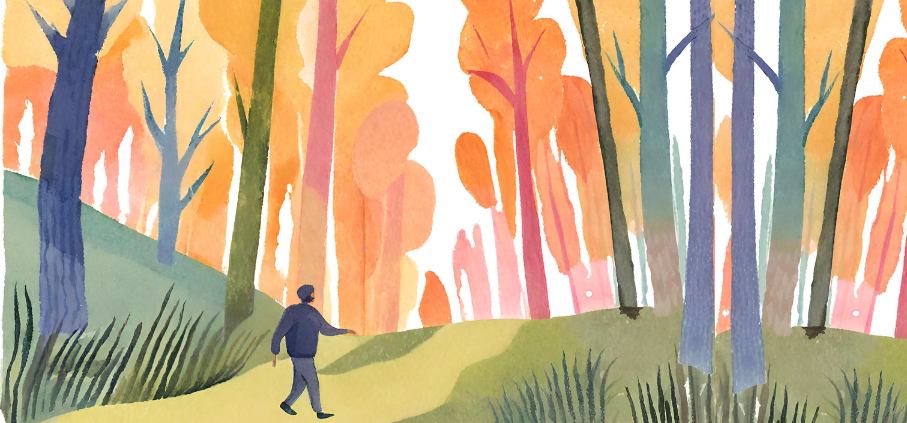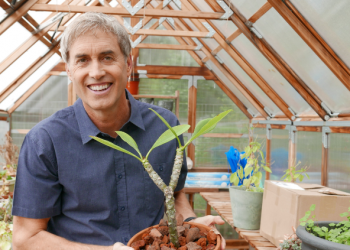The Unexpected Health Benefits of Forest Bathing
By Vedika Patani and Carly Smith, BS, MPH(c)

This blog is part of the Stress Management newsletter. If you like this content, sign up here to receive our monthly newsletter!
Many people know that hiking in nature can help reduce stress and anxiety. But not everyone knows that forest bathing is a way to take the therapeutic effects of a scenic walk to the next level. While hiking is a great way to get outdoors and exercise, forest bathing is a practice of being calm and quiet among trees and being present with our natural surroundings.
“Both hiking and forest bathing harness the power of nature to offer a wide range of benefits for our physical and mental wellbeing,” says Rusly Harsono, MD, head of Stanford Lifestyle Medicine Social Engagement and Clinical Assistant Professor at the Stanford School of Medicine. “Hiking provides an outdoor activity that activates our nervous system for greater physical health, whereas forest bathing calms our nervous system and improves our emotional wellbeing, which is equally important to physical health.”
s
What is Forest Bathing?
Forest bathing, or Shinrin Yoku, originated in Japan in the 1980s and involves taking deep breaths and experiencing the forest with full presence. Contrary to hiking, where the mind can still ruminate about work or challenging relationships, forest bathing is a mindfulness practice in that it brings the mind into the present moment by taking in the forest with all five senses. For example, a forest bather would visually observe the colors of the leaves and stop to notice the sun’s rays through the trees. They might close their eyes and take in a deep breath through the nose to capture the scent of pine. As they take a step, they may hear the crackling of a fallen leaf from under their shoe, and then pause to notice the sensation of the wind on their cheeks.
During the pandemic, forest bathing grew in popularity in the US as people searched for ways to calm their nervous system and connect outdoors while social distancing. But forest bathing is proving to be more than a lifestyle trend. Research is attributing this practice to numerous health benefits.
Forest Bathing and Mental Health
While hiking focuses on the improvement of physical fitness, forest bathing fosters improved mental and emotional health. Some people who experience anxiety find that forest bathing calms their nervous system because their attention shifts from their worries to noticing the natural elements all around them—and these results are scientifically measurable.
Studies show that forest bathing can decrease the stress hormone cortisol. In one meta-analysis, researchers reviewed 971 articles and found that forest bathing effectively reduced serum and salivary cortisol levels, indicating its potential to reduce stress.
Another meta-analysis reviewed studies where forest bathing was introduced to people living in urban environments, who generally have a higher risk of hypertension and psychological stress. Not only did the practice reduce their stress, but it also significantly lowered their blood pressure.
“Forest bathing can be beneficial for everyone, but it is particularly advantageous for individuals living in urban environments,” says Dr. Harsono. “Urban dwellers typically experience higher stress levels, noise pollution, and reduced access to natural settings. Forest bathing provides them a valuable opportunity to escape these stressors and experience improved wellbeing through connection with nature.”
A Natural Immune Supporter
Forest bathing is not just important for improving wellbeing, but it may also improve one’s physical health. Studies have found that forest bathing could increase immune cell activity and aid in the expression of anti-cancer proteins. In one study, a group of 12 men aged 37-55 spent three days practicing forest bathing in three different forests. Afterward, the men showed a 50 percent increase in natural killer cells (which can kill tumor cells) and an increase in the anti-cancer proteins perforin, granzymes, and granulysin.
Another research study showed that forest bathing improved immune function. When we inhale the oils released from trees (phytoncides), our cortisol levels decrease, and natural killer cell activity increases. These findings suggest forest bathing may have a preventive effect on cancer due to its ability to stimulate immune responses; however, more research needs to be conducted to better understand this phenomenon.
Forest Bathing Everywhere
One would think that forest bathing is only possible if you live in the country, however, this study showed that urban forest bathing (i.e. being mindful at a nearby park) still brought feelings of peacefulness to adolescents that live in metropolitan areas. This study observed the changes in the mental wellbeing of 44 adolescents before and after urban forest bathing. The results reported reduced anxiety, rumination, and skepticism, as well as increased feelings of social connectedness.
Lastly, landscape designers have taken note of the research supporting the healing effects of nature. At Stanford’s Lucile Packard Children’s Hospital in the heart of the San Francisco Bay Area, patients and their families have access to gardens and outdoor spaces to stroll and mindfully take in the natural beauty.
“Lucile Salter Packard’s vision for the hospital was to nurture the body and soul of every child by creating a restorative environment by integrating nature and art,” says Dr. Harsono, Pediatrician at Stanford Medicine Children’s Health. “We frequently bring children to the hospital garden during their recovery to help them manage their treatment and discomfort. Research supports this idea of incorporating forest bathing experiences into the care of sick children to improve their health outcomes and overall quality of life.”






















